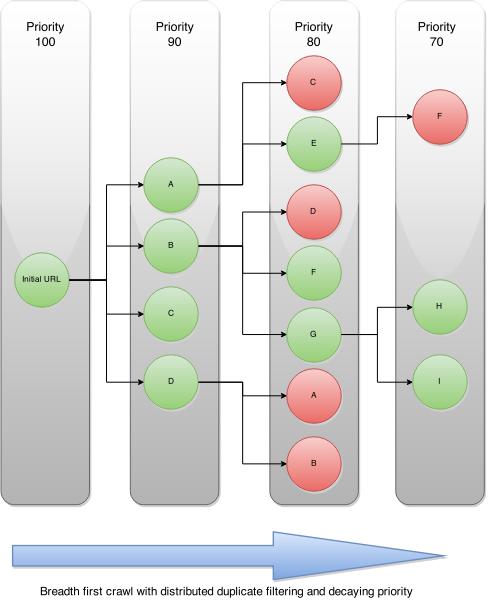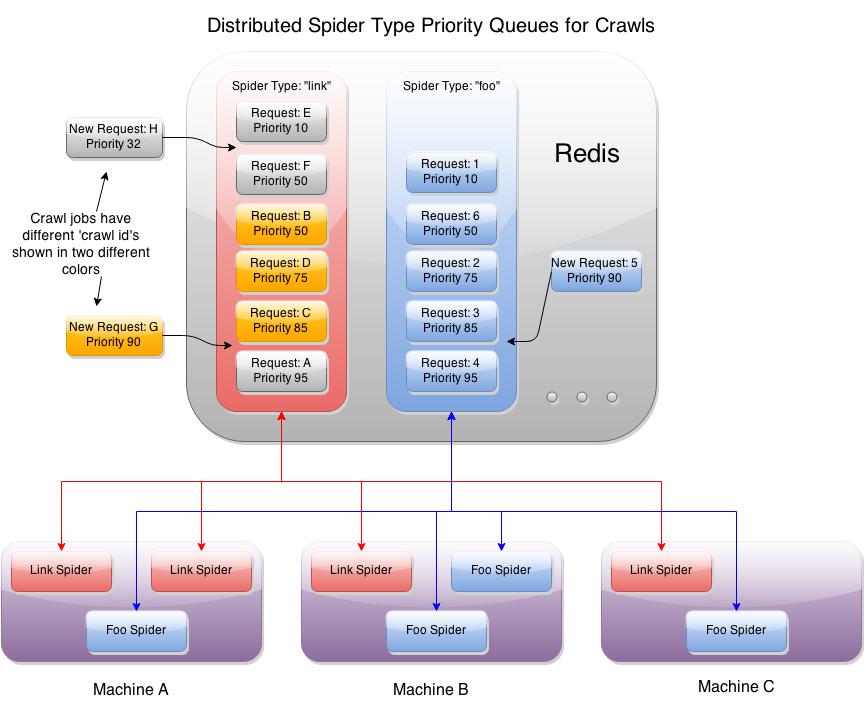Crawler¶
The Scrapy Cluster allows for multiple concurrent spiders located on different machines to coordinate their crawling efforts against a submitted crawl job. The crawl queue is managed by Redis, and each spider utilizes a modified Scrapy Scheduler to pull from the redis queue.
After the page has been successfully crawled by the spider, it is yielded to the item pipeline for further processing. If the page was not successfully crawled, the retry middleware included with Scrapy Cluster will resubmit the page back to the queue, to potentially be tried by another spider.
A generic link spider has been provided as a starting point into cluster based crawling. The link spider simply crawls all links found on the page to the depth specified by the Kafka API request.
Quick Start¶
This is a complete Scrapy crawling project.
First, make sure your settings.py is updated with your Kafka and
Redis hosts.
To run the crawler offline test to make sure nothing is broken:
python tests/tests_offline.py -v
Then run the crawler:
scrapy runspider crawling/spiders/link_spider.py
To run multiple crawlers, simply run in the background across X number of machines. Because the crawlers coordinate their efforts through Redis, any one crawler can be brought up/down in order to add crawling capability.
- To execute a crawl, please refer the Kafka Monitor documentation
- To learn more about how to see crawl info, please see the Redis Monitor documentation
Design Considerations¶
The core design of the provided link spider is that it tries to be simple in concept and easy to extend into further applications. Scrapy itself is a very powerful and extendable crawling framework, and this crawling project utilizes a unique combination of extensions and modifications to try to meet a new cluster based crawling approach.
Every spider in the cluster is stand alone, meaning that it can function as a complete Scrapy spider in the cluster without any other spiders or processes running on that machine. As long as the spider can connect to Kafka and Redis then you will have a complete working ‘cluster’. The power comes from when you stand multiple crawlers up on one machine, or spread them across different machines with different IP addresses. Now you get the processing power behind a Scrapy spider and the benefit of redundancy and parallel computations on your crawl job.
Each crawl job that is submitted to the cluster is given a priority, and for every subsequent level deep in the crawl that priority decreases by 10. An example diagram is shown below:

As you can see above. the initial seed url generates 4 new links. Since we are using a priority based queue, the spiders continue to pop from the highest priority crawl request, and then decrease the priority for level deep they are from the parent request. Any new links are fed back into the same exact queue mechanism but with a lower priority to allow for the equal leveled links to be crawled first.
When a spider encounters a link it has already seen, the duplication filter based on the request’s crawlid will filter it out. The spiders will continue to traverse the resulting graph generated until they have reached either their maximum link depth or have exhausted all possible urls.
When a crawl is submitted to the cluster, the request it placed into its own specialized spider based queue. This allows you to have multiple spiders doing vastly different link strategies coordinated via the same Redis instance, and even on the same machines!

The diagram above shows that you can have multiple instances of different spiders running on the same machines, that are all coordinated through a single redis instance. Since every spider knows its own type, it uses the request scheduler to pull new requests from the queue with its name. New requests that come in from Kafka, and requests generated by finding new links while spidering are all sent back into the same priority queue to be crawled.
For example, you can have an ongoing crawl that submits high depth crawl jobs beginning at a priority of 70. These crawls take a lot of resources and will continue to run, but if a user decides to submit a crawl of priority 90, they will immediately get their crawl result returned to them.
Overall, the designs considered for the core scraping component of Scrapy Cluster enable:
- Extendable crawlers thanks to Scrapy
- Distributed crawl efforts across arbitrary machines
- Multiple spider processes capable of independent logic
- Coordinated, lossless frontier expansion of the crawl job
Components¶
This section explains the individual files located within the crawler project.
distributed_scheduler.py¶
A Scrapy Scheduler that tries to find new requests from the Redis queue associated with the spider’s name. Since we are using a link spider, the queue it will look under will be called link:queue.
The scheduler has all of the same overridden functions you would expect, except for has_pending_requests(). In our tests we found inconsistencies in Scrapy when returning True when grabbing a new item from within that function or letting the item be returned from next_request. For now we return False so that the spider goes back to idle, but it is worth investigating more in the future.
items.py¶
Holds a single basic item yielded by the crawlers to the item pipeline. The RawResponseItem returns other metadata associated with the crawl including:
- response url
- status code
- status message
- headers
- body text
- links found
- passed through attributes
pipelines.py¶
The pipelines file is a basic Scrapy Item Pipeline with a single class to take the yielded item and send it back to Kafka. It also checks to make sure that the Kafka topic exists before sending the message to it.
redis_dupefilter.py¶
An extremely basic class that serves as a crawl link duplication filter utilizing a Redis Set. This allows two important things:
- Any unique
crawlidwill not recrawl a url it has already seen - New crawl requests with a different
crawlidcan crawl those same links, without being effected by other crawl duplication filters
This allows for a crawl job over a variety of links to not waste resources by crawling the same things. If you would like to recrawl those same urls, simply submit the same url with a different crawl identifier to the API. If you would like to continue to expand your crawl frontier, submit a crawl with the same identifier.
Note
If you continue to submit the same crawlid and none of the urls have changed, the crawl prematurely stop because it found zero new links to spider.
redis_queue.py¶
A utility class that utilizes Pickle encoding to store and retrieve arbitrary sets of data in Redis. The queues come in three basic forms:
RedisQueue- A FIFO queue utilizing a Redis ListRedisStack- A Stack implementation utilizing a Redis ListRedisPriorityQueue- A prioritized queue utilizing a Redis Sorted Set. This is the queue utilized by the scheduler for prioritized crawls
All three of these classes can handle arbitrary sets of data, and handle the pickle encoding and decoding for you.
redis_retry_middleware.py¶
This class is a Scrapy Downloader Middleware that catches 504 timeout exceptions thrown by the spider. These exceptions are handled differently from other status codes because the spider never even got to the url, so the downloader throws an error.
The url is thrown back into the cluster queue at a lower priority so the cluster can try all other higher priority urls before the one that failed. After a certain amount of retries, the url is given up on and discarded from the queue.
redis_spider.py¶
A base class that extends the default Scrapy Spider so we can crawl continuously in cluster mode. All you need to do is implement the parse method and everything else is taken care of behind the scenes.
Note
There is a method within this class called reconstruct_headers() that is very important you take advantage of! The issue we ran into was that we were dropping data in our headers fields when encoding the item into json. The Scrapy shell didn’t see this issue, print statements couldn’t find it, but it boiled down to the python list being treated as a single element. We think this may be a formal defect in Python 2.7 but have not made an issue yet as the bug needs much more testing.
link_spider.py¶
An introduction into generic link crawling, the LinkSpider inherits from the base class RedisSpider to take advantage of a simple html content parse. The spider’s main purpose is to generate two things:
- Generate more urls to crawl, found by grabbing all the links on the page
- Generate a
RawResponseItemto be processed by the item pipeline.
These two things enable generic depth based crawling, and the majority of the code used within the class is to generate those two objects. For a single page this spider might yield 100 urls to crawl and 1 html item to be processed by the Kafka pipeline.
Note
We do not need to use the duplication filter here, as the scheduler handles that for us. All this spider cares about is generating the two items listed above.
lxmlhtml.py¶
This is actually a duplicate of the Scrapy LxmlParserLinkExtractor but with one slight alteration. We do not want Scrapy to throw link extraction parsing errors when encountering a site with malformed html or bad encoding, so we changed it to ignore errors instead of complaining. This allows for the continued processing of the scraped page all the way through the pipeline even if there are utf encoding problems.
In the future this may just be an extended class but for now it is the full copy/paste.